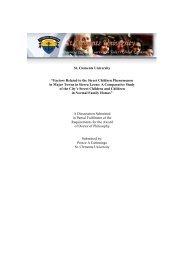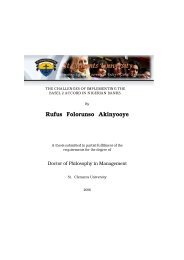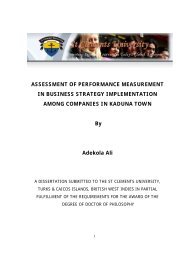The role of informal microfinance institutions in saving
The role of informal microfinance institutions in saving
The role of informal microfinance institutions in saving
You also want an ePaper? Increase the reach of your titles
YUMPU automatically turns print PDFs into web optimized ePapers that Google loves.
METHODOLOGY OF THE STUDY<br />
CHAPTER THREE<br />
3.1.0: Measurement <strong>of</strong> household <strong>in</strong> liv<strong>in</strong>g standard.<br />
<strong>The</strong> poorest 20 % households were chosen to represent average households <strong>in</strong> the country.<br />
S<strong>in</strong>ce poverty measures a sort <strong>of</strong> <strong>in</strong>equality that conf<strong>in</strong>es attention to a specified slice bottom<br />
<strong>of</strong> <strong>in</strong>come distribution, it was decided to choose arbitrary private <strong>in</strong>come received by the<br />
poorest 20% <strong>of</strong> households <strong>in</strong> the economy as the <strong>in</strong>come <strong>of</strong> the average households. <strong>The</strong>n<br />
through econometric, it was estimated the extent to which lend<strong>in</strong>g <strong>in</strong>terest rate <strong>of</strong> SACC0s has<br />
affected <strong>in</strong>come received by poorest 20 % households <strong>in</strong> the country i.e. how SACCOs has<br />
<strong>in</strong>creased monetary <strong>in</strong>come and contribution expenditures <strong>of</strong> poorest 20 percent households<br />
<strong>in</strong> Tanzania.<br />
Income Poverty.<br />
This is def<strong>in</strong>ed as the situation when households do not have enough <strong>in</strong>come to susta<strong>in</strong> the<br />
consumption expenditure <strong>of</strong> equal or more than 1 USD per day. Income poverty is the ma<strong>in</strong><br />
variable used <strong>in</strong> this study to assess the impact <strong>of</strong> SACCOs on the liv<strong>in</strong>g standard <strong>of</strong> the<br />
poorest 20 percent households <strong>in</strong> Tanzania.<br />
Non – <strong>in</strong>come poverty.<br />
This occurs when households have a bit little amount <strong>of</strong> money but they do not have access to<br />
basic consumer goods and services. Though non <strong>in</strong>come poverty have not been <strong>in</strong>cluded <strong>in</strong><br />
econometric analysis, it has been used whenever a need arise <strong>in</strong> order to highlight a particular<br />
po<strong>in</strong>t<br />
Informal Micro f<strong>in</strong>ance Institutions.<br />
<strong>The</strong>se are f<strong>in</strong>ancial <strong><strong>in</strong>stitutions</strong> whose activities fall outside the scope <strong>of</strong> formal f<strong>in</strong>ancial<br />
<strong><strong>in</strong>stitutions</strong>. <strong>The</strong>y <strong>in</strong>clude <strong><strong>in</strong>formal</strong> <strong>in</strong>dividual money lenders, sav<strong>in</strong>gs and credit cooperative<br />
societies and Sav<strong>in</strong>gs (SACCOs) and Credit Cooperatives Association (SACAs).<br />
153
















